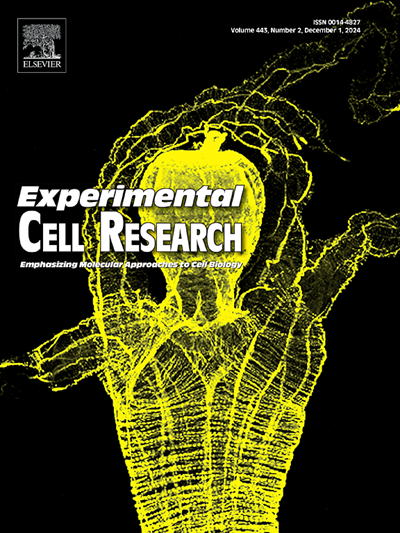在病理性血管生成中,moesin的磷酸化损害了血管基底膜的完整性
IF 3.5
3区 生物学
Q3 CELL BIOLOGY
引用次数: 0
摘要
我们之前的研究表明,晚期糖基化终产物(AGEs)通过moesin磷酸化促进人脐静脉内皮细胞(HUVECs)和小鼠视网膜的血管生成。age诱导的血管生成的特征是粘附连接处ve -钙粘蛋白分布异常和周细胞覆盖减少。在这项研究中,我们使用huvec -视网膜微血管周细胞(RMPs)共培养系统和age处理的小鼠模型进一步研究了IV型胶原(Col-IV)在新生血管基底膜(BM)内分布的变化。通过磷酸化调节探讨moesin磷酸化在ages诱导的BM异常中的作用。结果证实,在HUVECs-RMPs共培养系统中,age诱导未成熟血管生成,其特征是周细胞覆盖率下降,新生血管BM中Col-IV分布不均匀。在经ages处理的小鼠的视网膜血管中也观察到类似的结果。调节moesin磷酸化改变了ages诱导的血管BM中Col-IV的异常分布。我们在小鼠视网膜血管中观察到磷酸化moesin与异质粘附分子CD44的明显共定位。该研究表明,AGEs通过磷酸化moesin和破坏异质粘附连接形成,诱导血管BM中Col-IV的异常分布和随后的新血管不成熟。本文章由计算机程序翻译,如有差异,请以英文原文为准。
The phosphorylation of moesin impairs the integrity of vascular basement membrane in pathological angiogenesis
Our previous studies demonstrated that advanced glycation end products (AGEs) promote angiogenesis in human umbilical vein endothelial cells (HUVECs) and mouse retina through moesin phosphorylation. AGEs-induced angiogenesis is characterized by abnormal VE-cadherin distribution at adherens junctions and decreased pericytes coverage. In this study, we further investigated the alterations in collagen IV (Col-IV) distribution within the basement membrane (BM) of neovesssles using a HUVECs-retinal microvascular pericytes (RMPs) co-culture system and an AGEs-treated mouse model. The role of moesin phosphorylation in AGEs-induced BM abnormalities was explored through phosphorylation modulation. The results confirmed that AGEs-induced immature angiogenesis in HUVECs-RMPs co-culture system, characterized by decreased pericyte coverage and uneven Col-IV distribution in the neovessel BM. Similar results were observed in retinal vessels from AGEs-treated mice. Modulation of moesin phosphorylation altered the AGEs-induced maldistribution of Col-IV in the vascular BM. We observed obvious co-localization of phosphorylated moesin with heterogenous adhesion molecule CD44 in mouse retinal vessels. This study demonstrates that AGEs induce abnormal distribution of Col-IV in the vascular BM and subsequent neovessel immaturity via phosphorylation of moesin and disruption of heterogenous adhesion junction formation.
求助全文
通过发布文献求助,成功后即可免费获取论文全文。
去求助
来源期刊

Experimental cell research
医学-细胞生物学
CiteScore
7.20
自引率
0.00%
发文量
295
审稿时长
30 days
期刊介绍:
Our scope includes but is not limited to areas such as: Chromosome biology; Chromatin and epigenetics; DNA repair; Gene regulation; Nuclear import-export; RNA processing; Non-coding RNAs; Organelle biology; The cytoskeleton; Intracellular trafficking; Cell-cell and cell-matrix interactions; Cell motility and migration; Cell proliferation; Cellular differentiation; Signal transduction; Programmed cell death.
 求助内容:
求助内容: 应助结果提醒方式:
应助结果提醒方式:


